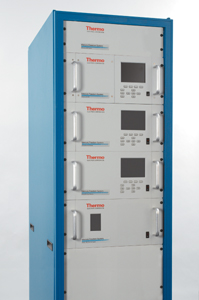Thermo Launches Mercury Freedom System At Electric Power Research Institute CEM User Group Meeting & Exhibit
•Brochure: Mercury Emissions Monitoring
Mercury Continuous Emission Monitoring System Bolsters Thermo Electron's Leadership Role in Stack Gas Monitoring in the U.S. Power Generation Market
 Savannah, GA — EPRI CEM User Group Meeting & Exhibit 2005 — Thermo Electron Corporation, the world leader in continuous emission monitoring instrumentation, today unveiled the Mercury Freedom System, one of the world's only mercury continuous monitoring systems that stands up to the rigorous standards of the U.S. Environmental Protection Agency's Performance Specifications 12A and the operating and maintenance requirements of the power generation industry.
Savannah, GA — EPRI CEM User Group Meeting & Exhibit 2005 — Thermo Electron Corporation, the world leader in continuous emission monitoring instrumentation, today unveiled the Mercury Freedom System, one of the world's only mercury continuous monitoring systems that stands up to the rigorous standards of the U.S. Environmental Protection Agency's Performance Specifications 12A and the operating and maintenance requirements of the power generation industry.
On March 15, 2005, the U.S. EPA issued its first ever Clean Air Mercury Rule to permanently cap and reduce mercury emissions from coal-fired power plants. When fully implemented, the rule aims to reduce utility emissions of mercury from 48 tons per year to 15 tons per year, a reduction of nearly 70 percent. The Thermo Mercury Freedom System utilizes a dilution extractive design and a dry thermal conversion system mounted at the stack, to help power generation plants efficiently and accurately meet these new requirements.
"Our Mercury Freedom System, more than two years in development, is an example of our commitment to the power generation industry and stack gas monitoring, and is an extension of our ongoing efforts to help power suppliers comply with regulations mandated under the 1990 Clean Air Act Amendments," noted Greg Herrema, president of Thermo's Environmental Instruments Division. "Recognizing the potential for a mercury monitoring requirement some time ago, we applied our analytical instrument and stack gas monitoring applications expertise to develop a mercury CEMS that we believe is the most cost effective, accurate, and reliable solution for our customers in the power generation industry."
This complete solution includes the following:
- Mercury Analyzer - The mercury analyzer is based upon atomic fluorescence. An advanced cold vapor atomic fluorescence design provides continuous sample measurement, with no additional gases or pre-concentration required and virtually no interference from SO2. Detection limits down to 1.0 ng/m3 allow high sample dilution (100:1) minimizing moisture, heat and interfering pollutants.
Mercury Calibrator - The elemental mercury calibrator was developed using a Peltier cooler/vapor pressure control and mass flow controllers. The mercury concentration output range is currently 0.1 µg/m3 to 300 µg/m3. This range allows the operator to directly calibrate the analyzer at post-dilution concentrations and dynamically spike into the sampling probe.
Zero Air Supply - The mercury analyzer is designed for use with a dilution probe. The zero air supply provides dry, mercury-free dilution air to the probe, zero gas for analyzer calibrations, and air to the mercury calibrator.
Stack Probe and Inertial Filter - The extraction probe uses an inertial filter to separate a particulate-free vapor-phase sample while minimizing the interactions with fly ash, which can cause sampling artifacts. All components that are exposed to sample gas are glass coated to prevent reactions with mercury. The probe incorporates a dilution assembly and calibration gas that can be introduced either upstream or downstream of the inertial filter.
Converter – A high temperature module converts all vapor phase species of mercury to elemental mercury for analysis. The proprietary, high efficiency conversion technology has been demonstrated to meet the U.S. EPA PS-12A criteria of less than 5 percent of span value deviation from the certified gas value.
Probe Control Box - The probe control box is located in the CEM shelter. An umbilical connects the probe to the probe control box and mercury converter. The unit:
- - Allows dynamic Hg spiking and auto dilution confirmation
- Automates probe calibration and dynamic spiking via Calibrator Microprocessor
- Measures fast loop flow
- Automates blowback via Calibrator Software
About Thermo Electron Corporation
Thermo Electron Corporation is the world leader in analytical instruments. Our instrument solutions enable our customers to make the world a healthier, cleaner and safer place. Thermo's Life and Laboratory Sciences segment provides analytical instruments, scientific equipment, services and software solutions for life science, drug discovery, clinical, environmental and industrial laboratories. Thermo's Measurement and Control segment is dedicated to providing analytical instruments used in a variety of manufacturing processes and in-the-field applications, including those associated with safety and homeland security. Based near Boston, Massachusetts, Thermo has revenues of more than $2 billion, and employs approximately 10,000 people in 30 countries.
Source: Thermo Fisher Scientific
Downloads:•Brochure: Mercury Emissions Monitoring
